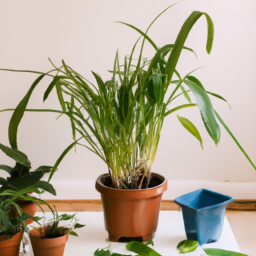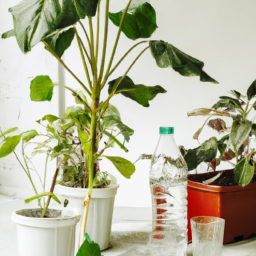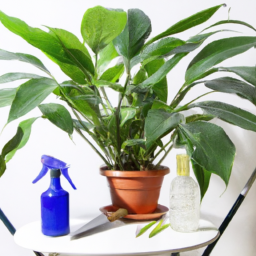
Are you wondering, “Should I repot indoor plants?” It’s a common question that many plant owners ask themselves at some point. Whether you’re a seasoned plant parent or just starting out with your indoor garden, knowing when and why to repot your plants is essential for their health and growth. In this blog post, we’ll explore the benefits of repotting indoor plants, signs that indicate it’s time for a new pot, and how to properly repot your beloved green friends. So, grab your gardening gloves and let’s dive into the world of repotting indoor plants!
Benefits of Repotting Indoor Plants
Repotting indoor plants is an essential task that many plant owners overlook. However, repotting your indoor plants can have numerous benefits for both the plants and the plant owner. In this article, we will explore the advantages of repotting indoor plants and provide you with a step-by-step guide on how to determine if your indoor plants need repotting.
Improved Plant Health
One of the primary benefits of repotting indoor plants is improved plant health. Over time, the soil in your plant’s current pot can become compacted, leading to poor drainage and a lack of oxygen reaching the plant’s roots. By repotting your indoor plants into fresh, nutrient-rich soil, you can ensure that your plants have the best possible growing conditions. This can lead to healthier, more vibrant plants with stronger root systems.
In addition, repotting your indoor plants allows you to inspect the plant’s roots for any signs of disease or rot. If you notice any issues with the roots, you can take action to address them before they spread and potentially harm the entire plant. By regularly repotting your indoor plants, you can catch these problems early and prevent them from becoming more serious.
Overall, repotting your indoor plants can help to promote better plant health and ensure that your plants thrive in their indoor environment.
Encourages Growth and Blooming
Another benefit of repotting indoor plants is that it can encourage growth and blooming. As indoor plants grow, they may become root-bound in their current pots, meaning that their roots have outgrown the pot and are becoming crowded. When a plant becomes root-bound, it can struggle to absorb nutrients and water from the soil, which can inhibit its growth and flowering.
By repotting your indoor plants into larger pots, you can provide them with more room to grow and spread out their roots. This can stimulate new growth and encourage your plants to bloom more frequently. Additionally, repotting your indoor plants can help to prevent them from becoming root-bound in the future, allowing them to continue growing and thriving in your home.
Overall, repotting indoor plants can help to promote healthy growth and encourage your plants to bloom, adding beauty and vibrancy to your indoor space.
Prevents Soil Depletion
One final benefit of repotting indoor plants is that it can prevent soil depletion. Over time, the soil in your plant’s pot can become depleted of nutrients, making it difficult for your plants to thrive. By repotting your indoor plants into fresh soil, you can provide them with the nutrients they need to grow and flourish.
Additionally, repotting your indoor plants allows you to refresh the soil and remove any built-up salts or minerals that may be harmful to your plants. This can help to prevent nutrient deficiencies and ensure that your plants have access to the resources they need to thrive.
Overall, repotting indoor plants can help to prevent soil depletion and provide your plants with the nutrients they need to grow and thrive in your indoor space.

Signs Your Indoor Plant Needs Repotting
Wilting or Yellowing Leaves
When your indoor plant starts to show signs of wilting or yellowing leaves, it may be a sign that it needs to be repotted. This is often caused by the plant outgrowing its current pot and becoming root-bound. When the roots have no more room to grow, they can become compacted and hinder the plant’s ability to absorb water and nutrients. As a result, the leaves may start to wilt or turn yellow due to a lack of proper nourishment. Repotting your plant into a larger container with fresh soil can help alleviate this issue and promote healthy growth.
Additionally, yellowing leaves can also be a sign of overwatering, which can lead to root rot. If you notice that the soil is consistently damp and the leaves are turning yellow, it may be time to repot your plant into a pot with better drainage to prevent waterlogged roots.
Roots Growing Through Drainage Holes
Another clear indication that your indoor plant needs repotting is when you see roots growing through the drainage holes at the bottom of the pot. This is a sign that the plant has outgrown its current container and is desperately seeking more space to grow. When roots are visibly coming out of the drainage holes, it’s time to repot your plant into a larger pot to give the roots room to spread out and thrive.
Leaving your plant in a pot that is too small can cause the roots to become tightly bound, leading to stunted growth and nutrient deficiencies. By repotting your plant into a larger container, you can provide it with the space it needs to develop a healthy root system and continue to flourish.
Slow Growth or Stunted Development
If you notice that your indoor plant’s growth has slowed down or it has become stunted in its development, it may be a sign that it needs to be repotted. When a plant is root-bound and doesn’t have enough room to grow, it can struggle to absorb water and nutrients effectively, which can result in slow growth and poor development.
Repotting your plant into a larger container with fresh soil can help stimulate new growth and encourage healthy development. By providing your plant with the space it needs to thrive, you can ensure that it continues to grow and flourish in its environment.
In conclusion, paying attention to the signs that your indoor plant needs repotting is crucial for its overall health and well-being. By recognizing these indicators and taking action to repot your plant when necessary, you can help promote healthy growth and ensure that your plant continues to thrive in its indoor environment.

How to Successfully Repot Indoor Plants
Assessing the Need for Repotting
When it comes to indoor plants, repotting is an essential task that should not be overlooked. But how do you know when it’s time to repot your indoor plants? There are a few key signs to look out for that indicate your plant may need a new home.
First, take a look at the roots of your plant. If they are starting to become crowded and are circling around the bottom of the pot, it’s a good indication that your plant has outgrown its current container. Additionally, if you notice that your plant is not thriving as it once was, with stunted growth or yellowing leaves, it may be time to consider repotting.
Another factor to consider is the soil in which your plant is currently growing. Over time, the nutrients in the soil can become depleted, leading to poor growth and overall health of the plant. If you notice that the soil is compacted and water is not draining properly, it may be time to repot your indoor plant.
Lastly, consider the overall appearance of your plant. If it looks top-heavy or unstable in its current pot, it may benefit from being repotted into a larger, more stable container.
Choosing the Right Pot and Soil
Once you have determined that your indoor plant is in need of repotting, the next step is to choose the right pot and soil for your plant. When selecting a new pot, make sure to choose one that is slightly larger than the current pot, allowing room for growth but not too much excess space. Additionally, make sure that the pot has proper drainage holes to prevent waterlogging.
When it comes to soil, choose a high-quality potting mix that is specifically formulated for indoor plants. Avoid using garden soil, as it can be too dense and may not provide adequate drainage for your plant. Look for a mix that is well-draining and rich in nutrients to support healthy growth.
Before repotting your plant, make sure to water it thoroughly a few hours beforehand. This will help to loosen the roots and make it easier to remove the plant from its current pot.
Repotting Your Indoor Plant
Now that you have everything you need, it’s time to repot your indoor plant. Start by gently removing the plant from its current pot, being careful not to damage the roots. If the roots are tightly packed, gently loosen them with your fingers to encourage new growth.
Next, add a layer of fresh potting mix to the bottom of the new pot, making sure to spread it evenly. Place your plant in the center of the pot and fill in the remaining space with more potting mix, gently pressing it down to secure the plant in place.
Once you have repotted your plant, water it thoroughly to help settle the soil and hydrate the roots. Place your plant in a location with adequate sunlight and continue to monitor its growth and health in the weeks following repotting.
By following these steps and paying attention to the signs that indicate your indoor plant needs repotting, you can ensure that your plant continues to thrive and grow in its new home. Remember, repotting is a crucial part of plant care that should not be overlooked.
Crisp Recap
If you’ve been wondering whether or not you should repot your indoor plants, the answer is: it depends. Repotting can be beneficial for your plants, as it allows them to have more space to grow and access fresh nutrients. However, it’s important to consider a few factors before making the decision to repot.
Firstly, take a look at the roots of your plant. If they are starting to become root-bound and circling around the bottom of the pot, it may be time to repot. Additionally, if your plant is showing signs of stress such as yellowing leaves or stunted growth, repotting could help revitalize it. Just make sure to choose a pot that is only slightly larger than the current one to prevent overpotting. Ultimately, repotting can be a great way to ensure the health and longevity of your indoor plants, but it’s important to do so carefully and with consideration for the specific needs of each plant.
FAQ Compilation:
Q1: Why should I repot my indoor plants?
A1: Repotting your indoor plants is important to provide them with fresh nutrients, space to grow, and prevent root-bound conditions. It also allows you to inspect the roots for any signs of disease or pests.
Q2: How often should I repot my indoor plants?
A2: The frequency of repotting indoor plants depends on the plant species, its growth rate, and the size of the pot. As a general rule of thumb, most plants benefit from being repotted every 1-2 years.
Q3: How do I know if my indoor plant needs repotting?
A3: Signs that your indoor plant needs repotting include roots growing out of the drainage holes, the plant becoming top-heavy, slow growth, and the soil drying out quickly. You can also gently lift the plant out of its pot to check the root system.
Q4: What is the best time of year to repot indoor plants?
A4: The best time to repot indoor plants is in the spring or early summer when they are actively growing. Avoid repotting during the dormant winter months as it can stress the plant.
Q5: How do I repot my indoor plants properly?
A5: To repot your indoor plants properly, choose a slightly larger pot with good drainage, use fresh potting mix, gently loosen the roots, place the plant in the new pot at the same depth, and water thoroughly. Allow the plant to adjust to its new home in a shaded area for a few days.

James Wong is a renowned ethnobotanist, plant scientist, and local television presenter. With a passion for demystifying plant science, he is known for translating complex botanical concepts into practical advice for everyday plant enthusiasts. James’s expertise spans from traditional gardening to cutting-edge plant technologies, making his insights accessible and informative.


